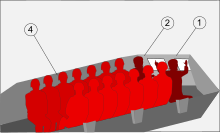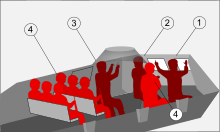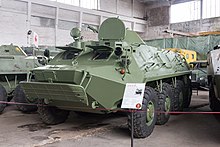BTR-60
| BTR-60 | |
|---|---|

Soviet armored personnel carrier BTR-60PB |
|
| General properties | |
| crew | 2 (commander, driver) + 14 men (BTR-60P) 2 (gunner, driver) + 8 men (BTR-60PB) |
| length | 7.22 m |
| width | 2.82 m |
| height | 2.06 m |
| Dimensions | 10 tons (BTR-60PB) |
| Armor and armament | |
| Armor | 9 mm (lower tub front), 7 mm (side) |
| Main armament | 1 × oversized 14.5 mm MG KPWT (BTR-60PB) |
| Secondary armament | 1 × 7.62 mm MG PKT |
| agility | |
| drive | 2 × 6-cylinder, GAZ-49B 2 × 66 kW (90 PS ) |
| suspension | Torsion bar suspension |
| Top speed | 80 km / h |
| Power / weight | 18 hp / ton |
| Range | 500 km |
The BTR-60 is an armored personnel carrier (original designation in Russian Бронетранспортёр , Bronjetransportjor, German translation: Panzer armored personnel carrier) from Soviet production.
The vehicle was developed in the late 1950s, first seen publicly in 1961, and various versions were built in series at least until the mid-1970s. The armored personnel carrier belonged among other things to the standard equipment of the motorized rifle troops of the NVA of the GDR and was carried there as SPW-60 (armored personnel carrier ). The vehicles were manufactured by GAZ and KZKT, among others .
Development and construction
The standard armored wheeled vehicle for transporting troops of the Soviet Army had been the BTR-152 since 1951 . The ZIL-153 was one of the test models that were considered for a possible successor ; a vehicle with three pairs of wheels, mounted equidistantly from one another, combined with a tub with plenty of ground clearance and buoyancy. The model, powered by a 180 hp engine, had been developed under the direction of LI Orlow from 1957, but was rejected in 1960 in favor of the BTR-60.
The successor to the BTR-152 was finally designed by the developers who had previously devised the BRDM-2 armored personnel carrier. They tried to use a diesel engine but the available JaAZ -206B was too heavy and would have made the vehicle too rear-heavy. The developers around WA Dedkow installed two 66 kW GAZ 49B gasoline engines in a floatable tub with eight wheels. As with the BTR-152, they resorted to civilian truck parts and used a modified version of the engine of the GAZ-51 .
The right gasoline engine drove the first and third pair of wheels, the left engine the second and fourth pair. Each engine was preceded by a four-speed gearbox, both gearboxes could be decoupled from the engine so that the vehicle could also be operated if one engine failed. The speed was up to 80 km / h on the road. A winch with 44 kN pulling force was installed in the tub bow , which was operated via the right differential gear . The vehicle weighed 9.5 tons and could transport up to fourteen soldiers with two crew members. The tub itself was open at the top and a machine gun could be mounted for self-defense.
On and off the road, steering was only possible using the two front pairs of wheels. For amphibious missions, a water jet drive was installed in the stern, with a 60 cm propeller sucking water through an opening in the floor and pushing it out of the tank at the stern. It was steered with two small oars, which were aligned by the driver with the normal steering wheel. Speeds of up to 10 km / h could be achieved in this way; the turning wheels alone sufficed in the water without the water jet drive for about 4 km / h forward movement. The light armor consists of welded steel plates.
The vehicle was the first in a line of four-axle armored personnel carriers developed for the Soviet land forces and the Warsaw Pact armies .
variants
The first prototype was ready in autumn 1959, and series production of the BTR-60P began in 1960 .
From 1963 the BTR-60P was built with a closed roof, this variant, the BTR-60PA , only had space for twelve passengers.
From 1965, the BTR-60PA received an armored turret in which an oversized 14.5 mm MG KPWT and a 7.62 mm MG were installed. The vehicle was also equipped with an overpressure system, increasing its weight to just over ten tons. This BTR-60PB could only carry eight passengers and two crew members, with the squad leader of the rifle squad also acting as commander as long as he was on board.
The TAB-71 emerged from a license agreement between the USSR and Romania in the 1970s , which differs in some points from the model, the BTR-60PB.
Problems
However, the BTR-60 has a number of weak points:
- Petrol engines with particularly flammable fuel
- high fuel consumption
- the crew compartment could only be left through the skylights and two small emergency hatches on the sides, which exposed the soldiers to enemy fire.
With the successor model BTR-70 the entry and exit problem was solved by additional hatches, the BTR-80 was finally equipped with diesel engines.
Use in armed forces
|
|
See also
Individual evidence
- ^ German Academy of Sciences in Berlin: German-Russian dictionary . H. H. Bielefeld, 7th unchanged edition, Akademie-Verlag, Berlin 1970, license number : 202 100/242/70, page 44 - "бронетранспорёр" = armored personnel carrier.
- ↑ a b Detailed website on the history of the vehicle, with images and technical data (Russian)
- ↑ www.fas.org: BTR-60 Armored Personnel Carrier (English)
- ↑ a b c d "История развития плавающих бронированных машин СССР и России" (Russian)
- ↑ a b c Армейские автомобили . avtomash.ru (Russian), accessed August 7, 2017.



